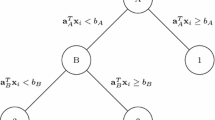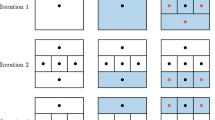Abstract
During the last decades, much research has been conducted on deriving classes of valid inequalities for mixed integer knapsack sets, which we call knapsack cuts. Bixby et al. (The sharpest cut: the impact of Manfred Padberg and his work. MPS/SIAM Series on Optimization, pp. 309–326, 2004) empirically observe that, within the context of branch-and-cut algorithms to solve mixed integer programming problems, the most important inequalities are knapsack cuts derived by the mixed integer rounding (MIR) procedure. In this work we analyze this empirical observation by developing an algorithm to separate over the convex hull of a mixed integer knapsack set. The main feature of this algorithm is a specialized subroutine for optimizing over a mixed integer knapsack set which exploits dominance relationships. The exact separation of knapsack cuts allows us to establish natural benchmarks by which to evaluate specific classes of them. Using these benchmarks on MIPLIB 3.0 and MIPLIB 2003 instances we analyze the performance of MIR inequalities. Our computations, which are performed in exact arithmetic, are surprising: In the vast majority of the instances in which knapsack cuts yield bound improvements, MIR cuts alone achieve over 87% of the observed gain.
Similar content being viewed by others
References
Achterberg, T., Koch, T., Martin, A.: MIPLIB 2003. Oper. Res. Lett. 34(4), 1–12 (2006). doi:10.1016/j.orl.2005.07.009. http://www.zib.de/Publications/abstracts/ZR-05-28/. See http://miplib.zib.de
Andonov R., Poirriez V., Rajopadhye S.: Unbounded knapsack problem: dynamic programming revisited. Eur. J. Oper. Res. 123, 394–407 (2000)
Applegate D., Bixby R.E., Chvátal V., Cook W.: TSP cuts which do not conform to the template paradigm. In: (eds) Computational Combinatorial Optimization, Optimal or Provably Near-Optimal Solutions [based on a Spring School], pp. 261–304. Springer-Verlag GmbH, London (2001)
Applegate D., Cook W., Dash S., Espinoza D.: Exact solutions to linear programming problems. Oper. Res. Lett. 35, 693–699 (2007)
Atamtürk A.: On the facets of the mixed–integer knapsack polyhedron. Math. Program. 98, 145–175 (2003)
Atamtürk A.: Sequence independent lifting for mixed–integer programming. Oper. Res. 52, 487–490 (2004)
Avella, P., Boccia, M., Vasilyev, I.: A computational study of exact knapsack separation for the generalized assignment problem. Technical report available at Optimization Online (2006)
Balas E., Perregaard M.: A precise correspondence between lift-and-project cuts, simple disjuntive cuts, and mixed integer Gomory cuts for 0–1 programming. Math. Program. 94, 221–245 (2003)
Balas E., Saxena A.: Optimizing over the split closure. Math. Program. 113(2), 219–240 (2008)
Balas E., Zemel E.: Facets of knapsack polytope from minimal covers. SIAM J. Appl. Math. 34(1), 119–148 (1978)
Bellman R.E.: Dynamic Programming. Princeton University Press, Princeton (1957)
Bixby, R., Gu, Z., Rothberg, E., Wunderling, R.: Mixed integer programming: a progress report. In: The sharpest cut: the impact of Manfred Padberg and his work. MPS/SIAM Series on Optimization, pp. 309–326
Bixby R.E., Ceria S., McZeal C.M., Savelsbergh M.W.P.: An updated mixed integer programming library: MIPLIB 3.0. Optima 58, 12–15 (1998)
Bonami P., Cornuéjols G., Dash S., Fischetti M., Lodi A.: Projected Chvátal Gomory cuts for mixed integer linear programs. Math. Program. 113(2), 241–257 (2008)
Boyd A.E.: Fenchel cutting planes for integer programs. Oper. Res. 42, 53–64 (1992)
Cook W., Kannan R., Schrijver A.: Chvátal closures for mixed integer programming problems. Math. Program. 47, 155–174 (1990)
Cornuéjols G., Li Y., Vanderbussche D.: K-cuts: a variation of Gomory mixed integer cuts from the LP tableau. INFORMS J. Comput. 15(4), 385–396 (2003)
Crowder H., Johnson E., Padberg M.: Solving large-scale zero-one linear-programming problems. Oper. Res. 31(5), 803–834 (1983)
Dantzig G.B.: Discrete variable extremum problems. Oper. Res. 5(2), 266–277 (1957)
Dash, S., Günlük, O.: On the strength of gomory mixed-integer cuts as group cuts. IBM research report RC23967 (2006)
Dash, S., Günlük, O., Lodi, A.: On the MIR closure of polyhedra. In: Fischetti, M., Williamson, D. (eds.). IPCO, Lecture notes in computer science, vol. 4513, pp. 337–351 (2007)
Dolan E., Moré J.: Benchmarking optimization software with performance profiles. Math. Program. 91(2), 201–213 (2001)
Eisenbrand F., Laue S.: A linear algorithm for integer programming in the plane. Math. Program. 102(2), 249–259 (2005)
Fischetti, M., Lodi, A.: On the knapsack closure of 0–1 integer linear problems. In: Presentation at 10th International Workshop on Combinatorial Optimization, Aussois (2006). Available at http://www-id.imag.fr/IWCO2006/slides/Fischetti.pdf
Fischetti M., Lodi A.: Optimizing over the first Chvátal closure. Math. Programm. B 110(1), 3–20 (2007)
Fischetti, M., Salvagnin, D.: A local dominance procedure for mixed-integer linear programming. http://www.dei.unipd.it/~fisch/papers/MIPdominance.pdf
Fischetti M., Toth P.: A new dominance procedure for combinatorial optimization problems. Oper. Res. Lett. 7, 181–187 (1988)
Fukasawa, R.: Single-row mixed-integer programs: Theory and computations. Ph.D. thesis, Georgia Institute of Technology (2008)
Gomory R.E.: Early integer programming (reprinted). Oper. Res. 50(1), 78–81 (2002)
Gomory R.E., Johnson E.: Some continuous functions related to corner polyhedra I. Math. Program. 3, 23–85 (1972)
Goycoolea, M.: Cutting planes for large mixed integer programming models. Ph.D. thesis, Georgia Institute of Technology (2006)
Granlund, T.: The GNU multiple precision arithmetic library. Available on-line at http://www.swox.com/gmp/
Gu Z., Nemhauser G.L., Savelsbergh M.W.P.: Lifted cover inequalities for 0–1 integer programs: computation. INFORMS J. Comput. 10, 427–437 (1998)
Gu Z., Nemhauser G.L., Savelsbergh M.W.P.: Sequence independent lifting in mixed integer programming. J. Combin Optimiz. 4(1), 109–129 (2000)
Horowitz E., Sahni S.: Computing partitions with applications to the knapsack problem. J. ACM 21, 277–292 (1974)
Ibaraki T.: The power of dominance relations in branch-and-bound algorithms. J. ACM 24, 264–279 (1977)
Kannan R.: A polynomial algorithm for the two-variable integer programming problem. J. ACM 27, 118–122 (1980)
Kaparis, K., Letchford, A.: Separation algorithms for 0–1 knapsack polytopes. Technical report available at Optimization Online (2007)
Kellerer H., Pferschy U., Pisinger D.: Knapsack Problems. Springer, Berlin (2004)
Marchand H., Wolsey L.: Aggregation and mixed integer rounding to solve MIPs. Oper. Res. 49, 363–371 (2001)
Martello S., Toth P.: Knapsack Problems: Algorithms and Computer Implementations. Wiley, New York (1990)
Nemhauser G.L., Wolsey L.A.: A recursive procedure for generating all cuts for 0-1 mixed integer programs. Math. Program. 46, 379–390 (1990)
Nemhauser, G.L., Wolsey, L.A.: Integer and Combinatorial Optimization. Discrete Mathematics and Optimization. Wiley, New York (1999)
Savelsbergh M.: Preprocessing and probing for mixed integer programming problems. ORSA J. Comput. 6, 445–454 (1994)
Scarf H.E.: Production sets with indivisibilities—part II: the case of two activities. Econometrica 49, 395–423 (1981)
Wolsey L.: Facets and strong valid inequalities for integer programs. Oper. Res. 24(2), 367–372 (1976)
Yan X.Q., Boyd E.A.: Cutting planes for mixed-integer knapsack polyhedra. Math. Program. 81(2), 257–262 (1998)
Zemel E.: Lifting the facets of zero-one polytopes. Math. Program. 15(1), 268–277 (1978)
Author information
Authors and Affiliations
Corresponding author
Rights and permissions
About this article
Cite this article
Fukasawa, R., Goycoolea, M. On the exact separation of mixed integer knapsack cuts. Math. Program. 128, 19–41 (2011). https://doi.org/10.1007/s10107-009-0284-7
Received:
Accepted:
Published:
Issue Date:
DOI: https://doi.org/10.1007/s10107-009-0284-7




